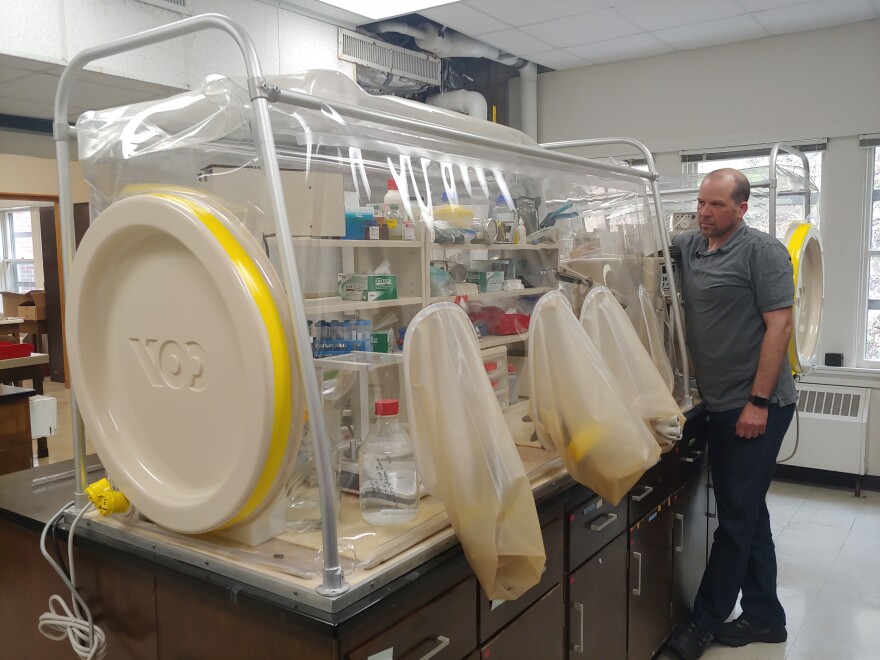Wisconsin scientists are working on new ways to protect drinking and surface water from pollutants. They’re also investigating better methods of cleaning water that's already contaminated. But researchers say success may cost taxpayers more money.
Department of Natural Resources (DNR) Secretary Preston Cole has been promising to place a higher priority on good science when crafting policy. For example, he hopes better research will lead to cleaner drinking water.
» See More Project Milwaukee: Great Lakes, Troubled Waters Stories
"We have communities around this state that have lost surety about turning on their pipes and having fresh drinking water. In certain parts of the state, it's PFAs [chemicals used in firefighting foam and other products] — emerging contaminants. In the southwest, there's nitrate in drinking water. And lead laterals continue to wreak havoc on some of our urban and oldest cities around the state of Wisconsin," Cole explains.
According to engineering professor Matthew Ginder-Vogel, expert help is on hand.
"I think scientists, we actually know a lot of the answers already as to how to protect drinking water," Ginder-Vogel says.
READ: How Perceptions Impact Whether People Drink Tap Water
He says state maps from as long as 35 years ago show which groundwater storage areas, known as aquifers, are potentially susceptible to contamination. So, one thing scientists are doing is working on ways to keep pollutants out of those waters, Ginder-Vogel says.
In northeastern Wisconsin, researchers are recommending ways to limit manure runoff into shallow soils. For other parts of the state that are troubled by naturally-occurring sources of contamination like radium, including Waukesha County, the answers may begin in the laboratory.
READ: Pollutants Are Abundant In Waterways Surrounding Milwaukee County

In Ginder-Vogel's lab, a vacuum pump removes oxygen from an anaerobic chamber — a 4-by-8 foot work area with clear plastic walls. Once a mix of nitrogen and hydrogen gas goes in, scientists insert their arms into plastic sleeves on the front of the chamber to conduct experiments with small vials of crushed rock taken from deep underground. The material is treated with a succession of acids to see how much radium comes out, as well as radium's sources, uranium and thorium.
Ginder-Vogel says the eventual hope is to tell local officials how to avoid drilling wells into soil depths with high radium concentrations. " 'Don't drill all the way down. Drill down this far, and try to pull water from these parts of your aquifer, rather than another part of your aquifer,' " he explains.
He says other researchers at UW-Madison are looking at ways to remove a compound called BPA (bisphenol-A) from water. BPA is used in plastics and can disrupt the human endocrine system.
If governments can't keep chemicals out of drinking water supplies, Ginder-Vogel says improving water treatment may be the next best option. One of his colleagues is working on a process called advanced oxidation.
READ: Emerging Threats To Wisconsin's Water
"[Advanced oxidation] can transform organic chemicals into carbon dioxide essentially. And then, it'll bubble out of the water and be harmless,” he says.
Likewise, Ginder-Vogel says there's more study underway of reverse osmosis. Used in desalination in other parts of the world, reverse osmosis is when pressurized water passes through a permeable membrane that filters out unwanted molecules. But Ginder-Vogel says the newer techniques are more expensive.
"It's very energy intensive. And in Wisconsin, we have a real concern because a lot of the municipalities that get water from the ground are small," he says.
Ginder-Vogel says Milwaukee, which uses Lake Michigan for drinking water, will soon have more treatment debates, too, over how to keep algae blooms out of the water system.

Researchers at the UW-Milwaukee School of Freshwater Sciences are also going higher tech to try to protect water. Wisconsin Lt. Gov. Mandela Barnes and DNR Secretary Cole toured the Freshwater Sciences building in April. At one stop, school Dean Val Klump showed off a lab with a new gene sequencer that helps map the DNA of fish.
Klump says his researchers can now better understand how pharmaceuticals designed for humans affect fish genes, if drugs get into Lake Michigan.
"Once you know the mechanism, you have a fighting chance, maybe, to counteract that ... by saying, ‘OK. Can we re-engineer those drugs, those compounds, those commercial chemicals, so we're using green technology, green chemistry, if you will?' " Klump says.
Klump acknowledges the gene research has a ways to go. So, he agrees with other water scientists who say the best way to protect groundwater, lakes and rivers is to keep contaminants out.

Do you have a question about innovation in Wisconsin that you'd like WUWM's Chuck Quirmbach to explore? Submit it below.
_




